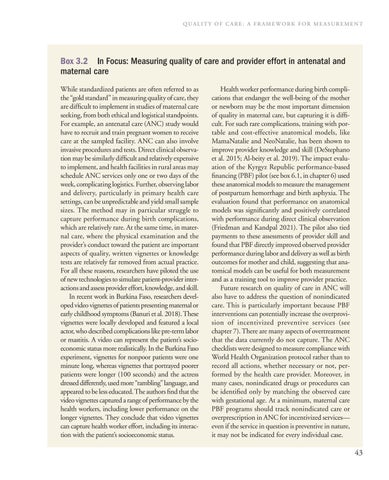QUALITY OF CARE: A FRAMEWORK FOR MEASUREMENT
Box 3.2 In Focus: Measuring quality of care and provider effort in antenatal and maternal care While standardized patients are often referred to as the “gold standard” in measuring quality of care, they are difficult to implement in studies of maternal care seeking, from both ethical and logistical standpoints. For example, an antenatal care (ANC) study would have to recruit and train pregnant women to receive care at the sampled facility. ANC can also involve invasive procedures and tests. Direct clinical observation may be similarly difficult and relatively expensive to implement, and health facilities in rural areas may schedule ANC services only one or two days of the week, complicating logistics. Further, observing labor and delivery, particularly in primary health care settings, can be unpredictable and yield small sample sizes. The method may in particular struggle to capture performance during birth complications, which are relatively rare. At the same time, in maternal care, where the physical examination and the provider’s conduct toward the patient are important aspects of quality, written vignettes or knowledge tests are relatively far removed from actual practice. For all these reasons, researchers have piloted the use of new technologies to simulate patient-provider interactions and assess provider effort, knowledge, and skill. In recent work in Burkina Faso, researchers developed video vignettes of patients presenting maternal or early childhood symptoms (Banuri et al. 2018). These vignettes were locally developed and featured a local actor, who described complications like p re-term labor or mastitis. A video can represent the patient’s socioeconomic status more realistically. In the Burkina Faso experiment, vignettes for nonpoor patients were one minute long, whereas vignettes that portrayed poorer patients were longer (100 seconds) and the actress dressed differently, used more “rambling” language, and appeared to be less educated. The authors find that the video vignettes captured a range of performance by the health workers, including lower performance on the longer vignettes. They conclude that video vignettes can capture health worker effort, including its interaction with the patient’s socioeconomic status.
Health worker performance during birth complications that endanger the well-being of the mother or newborn may be the most important dimension of quality in maternal care, but capturing it is difficult. For such rare complications, training with portable and cost-effective anatomical models, like MamaNatalie and NeoNatalie, has been shown to improve provider knowledge and skill (DeStephano et al. 2015; Al-beity et al. 2019). The impact evaluation of the Kyrgyz Republic performance-based financing (PBF) pilot (see box 6.1, in chapter 6) used these anatomical models to measure the management of postpartum hemorrhage and birth asphyxia. The evaluation found that performance on anatomical models was significantly and positively correlated with performance during direct clinical observation (Friedman and Kandpal 2021). The pilot also tied payments to these assessments of provider skill and found that PBF directly improved observed provider performance during labor and delivery as well as birth outcomes for mother and child, suggesting that anatomical models can be useful for both measurement and as a training tool to improve provider practice. Future research on quality of care in ANC will also have to address the question of nonindicated care. This is particularly important because PBF interventions can potentially increase the overprovision of incentivized preventive services (see chapter 7). There are many aspects of overtreatment that the data currently do not capture. The ANC checklists were designed to measure compliance with World Health Organization protocol rather than to record all actions, whether necessary or not, performed by the health care provider. Moreover, in many cases, nonindicated drugs or procedures can be identified only by matching the observed care with gestational age. At a minimum, maternal care PBF programs should track nonindicated care or overprescription in ANC for incentivized services— even if the service in question is preventive in nature, it may not be indicated for every individual case.
43

